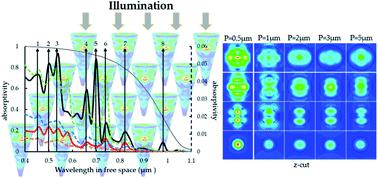当前位置:
X-MOL 学术
›
Nanoscale Adv.
›
论文详情
Our official English website, www.x-mol.net, welcomes your
feedback! (Note: you will need to create a separate account there.)
Broadband solar absorption with silicon metamaterials driven by strong proximity effects
Nanoscale Advances ( IF 4.6 ) Pub Date : 2020-04-02 , DOI: 10.1039/c9na00711c Ankit Chauhan 1 , Gil Shalev 1, 2
Nanoscale Advances ( IF 4.6 ) Pub Date : 2020-04-02 , DOI: 10.1039/c9na00711c Ankit Chauhan 1 , Gil Shalev 1, 2
Affiliation

|
Absorption of the solar radiation over a wide spectral range is of utmost importance to applications related to the harvesting of solar energy. We numerically demonstrate broadband solar absorption enhancement employing a metamaterial in the form of arrays composed of subwavelength silicon truncated inverted cones, henceforth referred to as light funnel (LF) arrays. We show that the broadband absorption efficiency of an unoptimized LF array is 36% greater compared with an optically-maximized NP array. We show that photon trapping in LF arrays is motivated by proximity effects related to the optical overlap between LFs. We make the distinction between two types of optical overlap: weak overlap in which the coupling between the sparse array modes and the impinging illumination increases with array densification, and strong overlap where the array densification introduces new highly absorbing modes. We show that in nanopillar (NP) arrays the optical intensity inside the NPs decreases upon densification and the overall increase in absorptivity is due to increase in filling ratio (as was also shown by others), while the densification of LF arrays increases the optical intensity inside the individual LF and with the concurrent increase in filling ratio concludes light trapping much superior to that of NP arrays. Light trapping governed by strong proximity effects was not reported to date, and we believe it is an important paradigm for miniaturized lab-on-chip technologies.
中文翻译:

由强邻近效应驱动的硅超材料宽带太阳能吸收
在宽光谱范围内吸收太阳辐射对于与收集太阳能有关的应用至关重要。我们在数值上证明了宽带太阳能吸收增强采用由亚波长硅截断倒锥组成的阵列形式的超材料,以下称为光漏斗 (LF) 阵列。我们表明,与光学最大化的 NP 阵列相比,未优化的 LF 阵列的宽带吸收效率高出 36%。我们表明,LF 阵列中的光子捕获是由与 LF 之间的光学重叠相关的邻近效应驱动的。我们区分了两种类型的光学重叠:弱重叠,其中稀疏阵列模式和撞击照明之间的耦合随着阵列致密化而增加,和强重叠,其中阵列致密化引入了新的高吸收模式。我们表明,在纳米柱 (NP) 阵列中,NP 内部的光强度在致密化时会降低,并且吸收率的总体增加是由于填充率的增加(如其他人所示),而 LF 阵列的致密化会增加光强度在单个 LF 内部并且随着填充率的同时增加,得出的结论是光捕获远优于 NP 阵列。迄今为止,尚未报道受强邻近效应控制的光捕获,我们相信它是小型化芯片实验室技术的重要范例。我们表明,在纳米柱 (NP) 阵列中,NP 内部的光强度在致密化时会降低,并且吸收率的总体增加是由于填充率的增加(如其他人所示),而 LF 阵列的致密化会增加光强度在单个 LF 内部并且随着填充率的同时增加,得出的结论是光捕获远优于 NP 阵列。迄今为止,尚未报道受强邻近效应控制的光捕获,我们相信它是小型化芯片实验室技术的重要范例。我们表明,在纳米柱 (NP) 阵列中,NP 内部的光强度在致密化时会降低,并且吸收率的总体增加是由于填充率的增加(如其他人所示),而 LF 阵列的致密化会增加光强度在单个 LF 内部并且随着填充率的同时增加,得出的结论是光捕获远优于 NP 阵列。迄今为止,尚未报道受强邻近效应控制的光捕获,我们相信它是小型化芯片实验室技术的重要范例。
更新日期:2020-04-02
中文翻译:

由强邻近效应驱动的硅超材料宽带太阳能吸收
在宽光谱范围内吸收太阳辐射对于与收集太阳能有关的应用至关重要。我们在数值上证明了宽带太阳能吸收增强采用由亚波长硅截断倒锥组成的阵列形式的超材料,以下称为光漏斗 (LF) 阵列。我们表明,与光学最大化的 NP 阵列相比,未优化的 LF 阵列的宽带吸收效率高出 36%。我们表明,LF 阵列中的光子捕获是由与 LF 之间的光学重叠相关的邻近效应驱动的。我们区分了两种类型的光学重叠:弱重叠,其中稀疏阵列模式和撞击照明之间的耦合随着阵列致密化而增加,和强重叠,其中阵列致密化引入了新的高吸收模式。我们表明,在纳米柱 (NP) 阵列中,NP 内部的光强度在致密化时会降低,并且吸收率的总体增加是由于填充率的增加(如其他人所示),而 LF 阵列的致密化会增加光强度在单个 LF 内部并且随着填充率的同时增加,得出的结论是光捕获远优于 NP 阵列。迄今为止,尚未报道受强邻近效应控制的光捕获,我们相信它是小型化芯片实验室技术的重要范例。我们表明,在纳米柱 (NP) 阵列中,NP 内部的光强度在致密化时会降低,并且吸收率的总体增加是由于填充率的增加(如其他人所示),而 LF 阵列的致密化会增加光强度在单个 LF 内部并且随着填充率的同时增加,得出的结论是光捕获远优于 NP 阵列。迄今为止,尚未报道受强邻近效应控制的光捕获,我们相信它是小型化芯片实验室技术的重要范例。我们表明,在纳米柱 (NP) 阵列中,NP 内部的光强度在致密化时会降低,并且吸收率的总体增加是由于填充率的增加(如其他人所示),而 LF 阵列的致密化会增加光强度在单个 LF 内部并且随着填充率的同时增加,得出的结论是光捕获远优于 NP 阵列。迄今为止,尚未报道受强邻近效应控制的光捕获,我们相信它是小型化芯片实验室技术的重要范例。










































 京公网安备 11010802027423号
京公网安备 11010802027423号